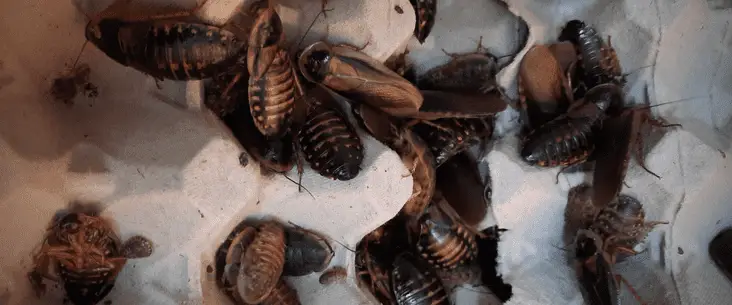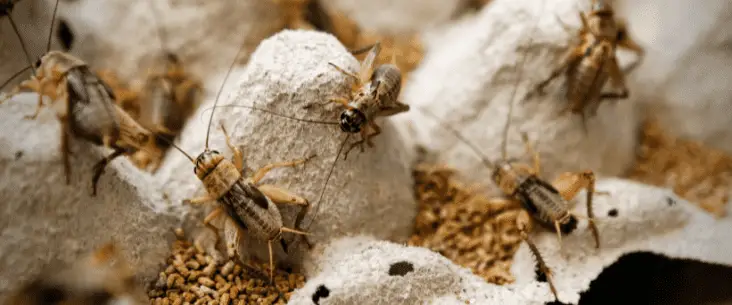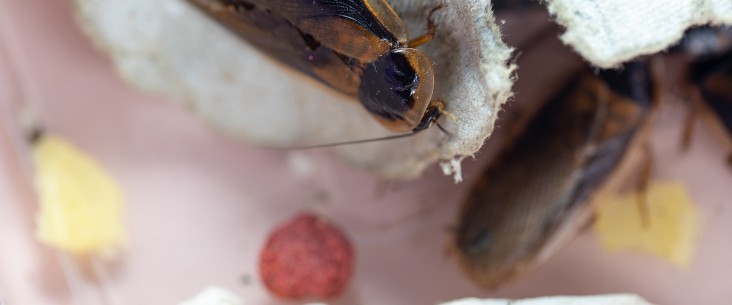You probably found an article about breeding feeder insects yourself and wondered if that would be a good option for you. Breeding feeder insects has many benefits in comparison with buying feeder insects, but there are some drawbacks to it as well. Here we take a closer look at both options so you can decide what option suits you best. In general, we can say the following.
Breeding feeder insects have several benefits over buying them, such as controlling the number of feeders, gut-loading and not depending on third parties deliveries. However, the benefits are most significant when having larger needs for feeder insects.
Choosing between buying or breeding really depends on your situation. Let’s discuss the pros and cons of breeding your own feeder insects to help you choose the best for your situation.
What should you choose?
If it is beneficial for you to breed your own feeder insects depends on several factors. Breeding feeder insects is not always the best option. First, let’s look at these different factors.
Number of animals to feed: If breeding insects is something for you depends in the first place how many feeder insects you’ll need. In other words, how many animals you’ll need to feed, although certain insect-eating animals have a big appetite. If you only have one animal that doesn’t eat many insects, then it is not useful or practical to breed your own feeder insects. A tarantula is a good example. They don’t eat many insects, and if you only have one, breeding the necessary insects is not really helpful.
Availability: Live insects are not available in every region, and when it is difficult to get feeder insects, it would be an option to breed them yourself. However, you’ll need to consider what to do with the excess numbers of feeder insects if breeding goes (too) well.
Costs: Although breeding your own feeder insects can be cost-effective if you only need a handful of insects every given time, it is not beneficial to start your own breeding colony. Secondly, to facilitate a breeding colony, you’ll need to make a certain investment before you can start breeding your own insects.
Now, when you considered these factors and still think about breeding your own feeder insects, have a look at the different pros and cons.
Pros and cons of breeding feeder insects
There are several pros and cons to breeding your own feeder insects. Maybe not every aspect is relevant for you or your situation, but it is important to understand the different benefits and drawbacks. First, let’s discuss the benefits of breeding your own feeder insects.
When needing large quantities, it’s cheaper
Yes, when you need large quantities of feeder insects (in the case of many animals or animals with a big appetite), it can be cheaper to breed your own; at least when you don’t include your “labour” costs. The cost goes down per insect when you have large breeding colonies. Additionally, when it is possible, you can sell your own feeder insects to other keepers. In that way. you can make a little cost compensation for your efforts of breeding your own feeder insects.
No transport time
A very huge plus is that you don’t have the transport time when you’ll breed your own feeders. Transport and packaging have a negative impact on the well-being of the insects, making them less nutritious as feeder insects and a higher risk of premature death.
The reason is that the time a commercial breeder starts packaging the insects, they won’t eat that well. Mainly caused by stress and the fact that optimal food sources can’t be taken into the packaging. In pet stores, the insects stay on the shelf for several days before you buy them. By that time, their gut is rather empty and the feeder insects, even when not really visible from the outside, are not really healthy anymore.
Gut-loading from the start
One of my favourite reason to breed my own feeder insects is that you’ll know from the start what they eat. You are in control of what goes in and also can gut-load your feeder insects from the start. That means that you have really nutritious feeder insects for your animals. Although I believe that commercial breeders have all good intentions, you don’t know exactly what they have been fed.
Want to know more about gut-loading, read this article that goes in-depth about gut-loading feeder insects.
Different sizes at hand all the time
For the care of your animal, you’ll need certain sizes of feeder insects. However, it can be beneficial to have different sizes available. When you buy them, you are stuck to certain sizes. But when you breed them yourself, you’ll have all sizes available all the time. You can vary in which size you feed to them. Especially when you have the care for different insect-eating animals, this can be a big bonus.
Fun and fulfilling to breed your own
Okay, it is not really an advantage, but it can be really fun and also fulfilling to breed your own feeder insects. To sustain your own breeding colony. Because in the end, they are not only food; they are animals too. And as animal lovers, we like every animal, even when you have them as a food source, right?
It can be satisfying to see the development of the insects and a feeling of pride to breed them successfully, especially when you can sell partly to other animal keepers.

Breeding your own feeders definitely has a lot of benefits, and it may be the reason you are considering starting your own breeding colony. However, there are some drawbacks to breeding your own feeders that are important to mention. So don’t forget to consider those as well.
Some feeder insects can become pests
Some feeder insects are prone to escape. Crickets, for example, are really good at escaping. Not let it be that some insects may survive outside your breeding tank as well. And that may not be a problem immediately, but when they are also able to breed and become pests, it is much more troublesome.
Certain feeder insects, when the conditions in your house allow them, can become pests, and it may be difficult to get rid of them. One, in particular, is really problematic: red runner roaches. Even when you buy them is a risk. So don’t breed them in your house.
But also crickets, dubia roaches or fruit flies can become very annoying pests. So really consider which insects you’ll like to breed and how and where you want to breed them.
You’ll need to make an investment at first
As mentioned earlier, you need to make some investments before you can start breeding insects. You’ll need good housing and create optimal (climate) conditions for them. In the beginning, it is absolutely not the cheapest way to go.
It takes more space
Obviously, you’ll need more space when you want a breeding colony. You keep more animals for a sustainable colony, so you need larger tanks to keep them in. So critically think if you have the space for it and if you want to give up that space.
It can create a strange smell
Now, the opinion of this one differentiates between different people. Some think that feeder insects don’t smell (or only very lightly). Others can withstand the smell. It is also a smell that is hard to describe. Some insects, like dubia roaches, hardly smell (and it is more the food that smells), whereas others have a stronger smell.
When living with more people under one roof, it may be nice also to consider the other people what they think of the smell of feeder insects. Your wife/girlfriend may not be charmed by breeding your own feeder insects.
When you have too many feeders…
When you start breeding insects, it is very difficult to breed exactly the numbers you’ll need to feed your animals. And you particularly don’t want a shortage. But what to do when you have too many feeder insects?
It is important to have a plan for that scenario as well because it can be a major drawback when you have too many feeder insects to feed (unless you’ll like to keep and care for large groups of crickets…).
When you know people in your area that have insect-eating animal(s) as well, it could be a good idea to discuss and make a plan to share the results of a breeding colony. As long as you don’t throw live insects in the wild! They can become problematic for the area if they survive.

Where to start when breeding feeder insects
Breeding feeder insects is more than placing some animals together. You need to create proper breeding tanks and have proper management. Not all feeder insects are that easy to breed. I’ve written a whole article about which feeder insect is the easiest to breed. I certainly recommend you to read this article first.
Breeding feeder insects have three aspects that you need to consider. First, you’ll need proper housing (breeding tanks) for them to house in large numbers. Second, you have to provide nutritious food for them to grow and have a good gut content so you can feed them to other animals (gut-loading). Next, you’ll need to create good climate conditions for them to thrive so they will breed. And last, don’t forget they need care too, and that means cleaning the breeding tanks as well.
You can breed almost any feeder insect. For many feeders, I’ve created a practical breeding guide packed with tips so you can start your own breeding colony. Check them out with the links below:
- Dubia roaches breeding guide;
- Locust breeding guide;
- Cricket breeding guide;
- Superworms breeding guide;
- Springtail breeding guide;
- Fruit flies breeding guide.
You can find all articles that I’ve written here about feeder insects.
Where to buy feeder insects
If you, after reading this article, have second thoughts about breeding feeder insects or it is too big of a hassle, you can also buy feeder insects as well. There are different ways to buy them.
The easy way is to buy them online. Several pet stores and breeders sell feeder insects online and send them to your home address. Although this is easy and quite often pretty cheap, you don’t have much control over the quality. For example, you don’t know how long they were already in the store (often in a small package) and how the transport takes. Both are not good for the health of the insects, and that makes them less-quality feeders. When receiving feeders from the store, you’ll first need to keep them for a while and feed them well before using them as feeders.
Quality breeders oftentimes deliver higher quality feeders and are specialised in breeding quality insects. But still, they need to be sent, and when you receive them, they first need to be fed and taken care of for several days. So take that into account. I won’t say stores and breeders have bad quality (although some do); it is the time it takes for the feeder insects before they reach your address.
You can also go to the store and buy feeder insects there. Then at least, you’ll see the insects before you’ll buy them, and transport times are much shorter.
You can also buy feeder insects from the reptile and invertebrate expositions, but these expositions are not frequent enough for you to buy a steady supply.
Maybe you know someone in the neighbourhood that breeds feeder insects, and you can get some of him or her. That makes it easy for you and you can see where the insects come from. Generally, private insect breeders take good care of their breeding colonies.
Much more to learn!
I’ve written many articles about feeder insects. You can have a look at the suggested read or find all articles in the feeder insect section on this website.
Share this page!


